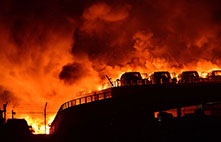5 myths about China's missile deployment on Yongxing Island
Updated: 2016-02-21 09:23
(chinadaily.com.cn)
|
||||||||
The South China Sea issue is back in the headlines again, this time thanks to the reports from Western media that China has deployed a missile system on Yongxing Island in the Xisha. The reaction from the United States has revealed a number of oddities and inconsistencies. Overall, there have been numerous claims, discords, critiques, and myths about the South China Sea. But this particular story has exposed at least five obvious confusions in the US strategy and stance in this region.
First, a confusion of the Xisha and Nansha. In the past, the international community has mostly focused on disputes involving the Nansha in the South China Sea, with China, Vietnam, and the Philippines as the claimants receiving the most attention. Concerns over the so-called "militarization" of the South China Sea are usually raised with regards to the Nansha. As a matter of fact, China has deployed limited defense measures in the Xisha for decades. Chinese defense capabilities on the Xisha have "nothing to do with militarization," as China's Foreign Ministry has clearly stated. Therefore, the missile deployment is not an intentional change to China's defense posture. The United States seems to intentionally be confusing the Nansha and the Xisha so as to better denounce China.
Second, a confusion of "right to self-defense" and "militarization." Article 51 of the UN Charter entitles UN members to the "inherent right" to self-defense. For decades, China's self-defense measures in the Xisha have not been regarded as a major issue, as currently pictured in the West. In fact, China's defenses in the Xisha have not been openly brought up by highest officials of the U.S. and its close allies until recently. How could this alleged deployment, on an island that has hosted Chinese defense facilities for decades, suddenly turn into a reckless step by China to intensify militarization in this region? Apparently China is not allowed to deploy defense capabilities on its own territory while the United States can deploy 60 percent of its Navy and Air Force in the Asia-Pacific region; continuously send spy planes and battleships for close-in reconnaissance of China's territory; and hold more and more frequent joint military drills in the region while selling large amount of military equipment. That's an odd definition of "militarization."
Third, a confusion of "intention" and "capability." According to U.S. media, the missiles deployed on Yongxing Island have a range of 125 miles and pose "a threat to all forms of civilian and military aircraft." This is another misunderstanding. First, China's self-defense measures obviously do not necessarily pose a threat to major sea lanes and air passages in this region, unless some incidental "innocent passages" evolve into seriously provocative threats to China's sovereignty. It is ridiculous to imagine China shooting missiles, unprovoked, at a civilian aircraft. Second, and more broadly, in this situation intention is just as important as capability. The United States maintains the most sophisticated weaponry system, defensive and offensive, ranging across the whole world, while it has constantly claimed to be a force for defending democracy, peace, and order. Why could not the same logic be applied to China? Simply put, capability does not directly pose a threat, but the "wrong" intentions do. As for China's intentions, the country has put forward a three-point initiative to uphold peace and stability in the South China Sea. China is determined to firmly uphold both "peace and stability" and its sovereign rights, now and in the future.
Forth, a confusion of the standards of militarization. The Philippines and Vietnam both "militarized" the islands they occupy long ago, and the U.S. continues to lead joint military exercises and make military sales. In this context, why are China's self-defense measures labelled as a direct military provocation? This is an obvious double-standard which the United States uses to try to monopolize international discourse. Such a stance seems to tell the world that it is only China's behaviors in this region that automatically should be linked to militarization.
Fifth, confusion about the "freedom of navigation" in the South China Sea. U.S. officials constantly claim their right to protect "freedom of navigation" in the South China Sea. For the past decades, civilian and commercial freedom of navigation in the South China Sea has never been sabotaged by China's military forces. Instead, it is the U.S. military "freedom of navigation" in the South China Sea that could be limited by China, if it is perceived as a threat to China's sovereignty. Thus, it is quite convenient for the United States to blame China for this somewhat imaginary "threat" to "freedom of navigation" to gain international support for its military operations in the South China Sea.
These generalizations about the South China Sea issue and particularly the intentional simplification of China's policies and behaviors may win the United States a certain amount of support in this region, but divergences and differences are emerging. For example, ASEAN leaders avoided criticizing China in the joint statement of the US-ASEAN special leaders' summit. This detail, and what it symbolizes about ASEAN's stance, is probably of more lasting significance that the media outcry over alleged Chinese missile deployment in the South China Sea.
- Missing children found safe in nearby village
- Rich Chinese splurge on sportswear as luxury's lustre dims
- Urgent remedy sought for pediatrician shortage
- China starts safety check for school buses as new semester draws near
- Ticket scalpers face crackdown at Beijing hospitals
- Judicial DNA test in hot demand after policy change
- Classic Car Show kicks off in London
- Balkan, Austria police agree to register refugees on Macedonian border
- Turkey blames Kurdish militants for Ankara bomb; vows reprisals
- Britain scrambles fighters to intercept Russian bombers
- Chinese community to protest against Peter Liang's verdict
- Car bomb attack on military in Turkish capital kills 28

 Chinese photographers' work shines in major photo contest
Chinese photographers' work shines in major photo contest
 88th Academy Awards Governors Ball Press Preview
88th Academy Awards Governors Ball Press Preview
 Egg carving master challenges Guinness World Record
Egg carving master challenges Guinness World Record
 Missing children found safe in nearby village
Missing children found safe in nearby village
 Madonna's world tour lands in Hong Kong
Madonna's world tour lands in Hong Kong
 Producing high-speed rail tracks
Producing high-speed rail tracks 
 Surreal world created by Canadian photographer
Surreal world created by Canadian photographer
 Lanterns light up the night across China
Lanterns light up the night across China
Most Viewed
Editor's Picks

|

|

|

|

|

|
Today's Top News
Investigation for Nicolas's campaign
Will US-ASEAN meeting be good for region?
Accentuate the positive in Sino-US relations
Dangerous games on peninsula will have no winner
National Art Museum showing 400 puppets in new exhibition
Finest Chinese porcelains expected to fetch over $28 million
Monkey portraits by Chinese ink painting masters
Beijing's movie fans in for new experience
US Weekly

|

|







